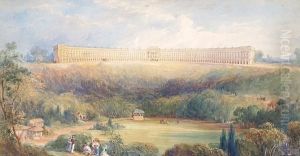Francis Goodwin Paintings
Francis Goodwin was an influential English architect during the early 19th century, known for his role in the Gothic Revival architecture movement. Born in 1784, Goodwin embarked on a career that would see him become one of the period's most imaginative and prolific architects, despite not always receiving the recognition of some of his contemporaries. His work is characterized by its ambitious scale, intricate detail, and the innovative use of Gothic and Elizabethan architectural styles.
Goodwin's architectural philosophy was deeply rooted in the revival of medieval Gothic architecture, which he believed was inherently British and more suitable for the country's climate and history than the classical styles that had been popular in the 18th century. This belief led him to design a number of churches, public buildings, and homes that were groundbreaking at the time for their return to what he saw as a 'true' national style. One of his most notable works is the design for the Church of St Mary in Stafford, which showcases his mastery of Gothic design elements and his ability to adapt historical styles to the needs of contemporary society.
Beyond his architectural work, Goodwin was also a prolific writer and theorist, publishing several books and articles on architecture. He advocated for the professionalization of architecture as a discipline and was a founding member of several architectural societies. Despite his contributions to the field, Goodwin's career was not without its controversies and challenges. He often found himself in financial difficulty, partly due to his ambitious projects and partly due to his sometimes extravagant lifestyle.
Francis Goodwin died in 1835, leaving behind a legacy of architectural innovation and a body of work that would influence the Gothic Revival movement in England for decades to come. His dedication to the revival of Gothic architecture and his contributions to the architectural profession have ensured his place in the history of British architecture.

![Domestic Architecture [cottage Architecture]](https://www.niceartgallery.com/imgs/624003/s/francis-goodwin-domestic-architecture-cottage-architecture-1ad97b57.jpg)